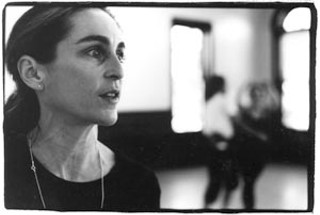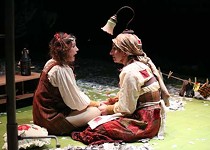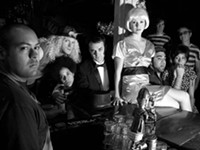Larkin's Journey
New York choreographer Regina Larkin keeps coming back to Ballet East
By Patti Hadad, Fri., Dec. 2, 2005

In 1989, at an international peace festival in Baghdad celebrating the end of Iraq's seven-year war with Iran, Regina Larkin had a revelation while dancers lifted her into the sky. "My head was way up," she recalls, "I looked at the moon, and it struck me that there is one common thing that we all have, and that's the sky." Such are the reveries of a creative modern dancer.
Last month, in the girl's gym at Martin Middle School on Austin's Eastside, Larkin spoke with equal fervor to a corps of novice dancers while rehearsing a dance for Divine Release, the fall 2005 production for Ballet East. For more than a quarter of a century, this modern dance company with a ballet base has been cultivating Latino artists and audiences, and Larkin has been a regular part of it. She has come down to Austin from New York, where she is artistic director of the Joyce Trisler Danscompany, to choreograph works in 10 of the company's productions, reflecting on topics as varied as spirituality, women, nature, Native Americans, and terminal illness to the melodies of Roberta Flack, Nina Simone, and Miles Davis.
This time around, the work conceptualizes humanity's response to misfortune, an idea that Ballet East Artistic Director Rodolfo Méndez drew out of Martha Graham's notion that headlines affect the muscles of the human body. "I was thinking of all the tragedies we've been having lately, like the hurricanes, earthquakes, and plagues, and thought it was worth exploring," says Méndez. It was under the sky in his back yard, just a short distance from the school, that Larkin warmed up with exercises, wrote poetry, and planned the movements of Hymn & Her.
At rehearsal, the company veterans pal around and stretch while sharing snacks and making jokes with the newcomers in the studio mirrors. Larkin stands bantamlike with a powerhouse body and lightly peppered hair before the varied colors and sizes of the Ballet East dancers. They work well off each other. Larkin says that being a part of Ballet East is like being part of a family. She watched Melissa Villarreal, who joined the company at the age of 14, grow into Ballet East's assistant artistic director and resident choreographer.
Larkin herself followed a similar path. At 16, she entered the famed Jacob's Pillow Dance School and a year later was granted full tuition at Adelphi University. After receiving her BA, she became part of the faculty in 1977. Two years later, she was the last dancer that Joyce Trisler herself selected for her company, just before the choreographer's untimely passing at the age of 45. Larkin was appointed associate director in 1986, then co-director, and ultimately director of the Danscompany, a position she has held for 12 years now. For one of her early performances with Ballet East, Larkin performed Trisler's Journey, a signature piece with the potential to be a classic like Graham's Diversion of Angels.
"I've always admired her work," says Méndez, who met Larkin in the 1980s when he was in New York studying dance with Milton Myers, Alvin Ailey, and Joyce Trisler. "It's so refined and stylized. Not very many other choreographers are doing what she's doing. With Regina, there's purpose and structure to the ballet. She's very spiritual, very organic, and her pieces are challenging to the dancers. A lot of it is psychological, not just arms, eyes, and feet."
Though she has only a week to spend with her performers this visit, Larkin still relinquishes an hour of rehearsal time to warming up and developing muscle memory. She was trained in the idiom of Lester Horton, the American modern dance pioneer who revolutionized the form on the West Coast much as Martha Graham did on the East. His technique is very demanding, with intense body strengthening and pelvic movements of African origins.
"He devised a form that doesn't challenge the body the way ballet does," says Larkin. "Ballet often has you turning out. His technique was kind of like the martial arts where they have one leg turned out and one leg parallel. It spirals through the shoulders, so you've got figure eights living inside your system. It's part of the whole philosophy. Keep going in the same direction so that when you go the other way the body has to return."

Next, Larkin directs the dancers in improvisational exercises, including a go-with-the-flow-of-the-group movement to the music of Morton Gould, specifically chosen for this dance because of his New Orleans influences. "I'm really proud at the way Texas responded to the hurricane relief," says Larkin. "I took the elements of the unrecognized people who have given up their life for the country to help and volunteer." She calls this her first national patriotism piece.
Her dancers are statues, which is not surprising considering that Larkin is also a sculptress. At 35, she received her MFA in sculpture at Adelphi. Larkin wants to create a memorial and has been pushing her dancers to go to the Umlauf Sculpture Garden. "I like to shape them like they're living clay," she says. "In sculpture, things aren't so balanced. Somehow those great sculptors make expression in stillness and create realisms. They have taken the traditions of the past, and they've created the future. That's what I'm trying to do with this dance of Hymn & Her."
The dancers look like industrial animals, moving repetitiously and writhing on the ground, then lifting each other up into the air. Over the course of 30 years, she developed what she calls "Larkinotation," a system of symbols to archive dances over music scores. Dancers can tune their listening skills and become receptive to self-interpretation to create original dance.
"Don't lose focus," she tells her dancers. "It's all evolving. We don't want to lose that magic. Look at each other. Dance as though the audience is all around you." Here, there is no cardinal rule dictating that one's front must be to the audience, so the dancers must be equally expressive with all areas of their bodies. "Your backs are the hardest things for the audience to interpret," Larkin tells them. "If you think you can turn away from them, and they can't see you, you're wrong. You have to make that expression in your limbs or your back."
None of the Horton progeny were above using theatrical hokum to attract audiences who were not particularly interested in avant-garde experimentations. But modern dancers also want to raise social consciousness through audience participation and kinesthetic response with violent and lyrical movement. And sometimes a little poetry.
Over Gould's melody an excerpt from Albert Schweitzer's The Spiritual Life is read: "At the present time when violence, clothed in life, dominates the world more cruelly than it ever has before, I still remain convinced that truth, love, peaceableness, meekness, and kindness are the violence that can master all other violence." By guiding the audience with text, Larkin believes that she can help them understand what she is trying to convey: peace overcoming a world dominated by violence.
"That's what we've tried to do through the Danscompany. You want to select something that interests your audience because there might be one person in the audience who would like a performance element work that speaks to them," says Larkin.
She had originally used the text in a piece called A Garden, in a City, of a Town. It was in her 55th rehearsal with her students at Adelphi in Garden City of Long Island when they had heard the news about September 11. Many of them were unable to return to their homes in Manhattan, so Larkin comforted them. "These kids were scared," she recalls. "Some of the Long Island kids had parents that were firefighters. So I said to them gently, 'Do you still want to rehearse?' They were just like, 'Please, we just want to be together.'" Inundated with personal tragedy, they instead created A Garden, in a City, of a Town as a memorial and healing.
When Larkin was little, she used to play Mass as though she and her brothers and sisters were holding the liturgy in their living room. Her brother eventually became a priest and on holidays really did hold the ritual in her house, spending hours afterward getting into philosophical discussions. When she traveled to Asia, Larkin studied Taoism and Buddhism, which she also applies to her choreography. "Each time I traveled, I didn't stay in the hotel room," she says. "I would go out with the stage manager, and we'd go out to the museums because I really believe that how could I touch people if I didn't know them."
Because Ballet East is community-based, with classes open to young hopefuls and a variety of ethnic choreographers, the audience is diverse and responsive. On stage in New York, Larkin has a harder time deciphering just what the onlookers are thinking. The response here in Ballet East has been like the night she danced in Baghdad, where the applause to honor a dancer is called a zaghareet, a high-pitch ululation with the tongue. "It felt like a thousand years went by in those eight counts," she says. "When the lights came up, I could see the happy families with their picnics. It was the only time I ever saw families together [in Baghdad]. I'll never forget that sound they made instead of clapping. I felt like a baseball player. Dancers are really God's athletes, to quote [Einstein]."
Ballet East performs Divine Release Dec. 1-4, Thursday-Saturday, 8pm, Sunday, 2pm, at the Dougherty Arts Center, 1110 Barton Springs Rd. For more information, call 474-TIXS or visit www.balleteast.org.








